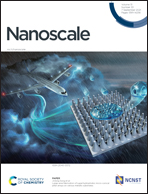Visible light-induced charge injection and migration in self-assembled carbon dot-DNA-carbon dot nano-dumbbell obtained through controlled stoichiometric conjugation†
Abstract
The potential of carbon dots (CDs) for photonic conversion to charged states, together with the ability of DNA to transport such charge for extensive charge separation, offers an opportunity to control directionality of migration for photo-induced radical cations in CD–DNA based nano-assemblies. This is achieved through engineering the reaction valency of CDs whereby one CD is covalently conjugated with one ssDNA strand. Subsequently, a CD-DNA-CD nano-dumbbell architecture was created through hybridization mediated self-assembly. The time and intensity-dependent transduction of visible light photonic energy to chemical potential in DNA was achieved through irradiation of 1,4-diaminoathraquinone and glyoxal derived CD with 100 W tungsten source and natural sunlight. Following charge injection by CD, the radical cation migration in DNA was perceived through trapping of the hole in repeated GG steps in the DNA. Overall, a breakthrough in visible-light-induced charge transfer by CD into DNA was achieved, potentially applicable to optobioelectronics.



 Please wait while we load your content...
Please wait while we load your content...